
Pages
▼
Tuesday, May 31, 2011
Monday, May 30, 2011
In Memory
O God, our Father,— Pope Benedict XVI, at Monte Cassino Abbey, May 24, 2009; translated by Joseph G. Trabbic
inexhaustible font of life and peace,
welcome into your merciful embrace
those who fell in the war that raged here,
those who fell in every war that has bloodied the earth.
Grant that they may rejoice in the light that does not fade,
that they glimpsed and desired in faith
during their earthly pilgrimage.
You, who in Jesus Christ, your Son,
offered to suffering humanity
the greatest testimony of your love,
and who through his Cross redeemed the world
from the dominion of sin and death,
grant to those who are still suffering
because of fratricidal war
the power of invincible hope,
the courage of daily acts of peace,
the active confidence in the civilization of love.
Pour forth your Holy Spirit, the Paraclete,
upon the men of our time,
so that they may understand that peace
is more precious than any corruptible treasure,
and may tirelessly work all together
to prepare for new generations
a world where justice and peace reign.
Father, good and merciful,
make us your sons and daughters in Christ,
perseverant builders of peace
and untiring servants of life,
the inestimable gift of your love.
Amen.
Sunday, May 29, 2011
"Four men ordained to the priesthood for archdiocese"
Click here for an article from the St. Louis Review.
And have a look at a video promoting the upcoming Eucharistic Congress:
http://archstl.org/eucharist
And have a look at a video promoting the upcoming Eucharistic Congress:
http://archstl.org/eucharist
Saturday, May 28, 2011
Breviarium Meum for the iPhone
A NEW APP, from the Franciscan Friars of the Immaculate, is now available for the Apple iPhone and iPod Touch.

Breviarium Meum is a free application, available from iTunes here. According to the Friars:
Click here to download Breviarium Meum.
The Universalis application for the iPhone provides the current English translation of the Divine Office of the Latin Rite, better known as the Liturgy of the Hours, as revised after the Council. You can purchase it by clicking here.
Click here for a more comprehensive list.

Breviarium Meum is a free application, available from iTunes here. According to the Friars:
Breviarium Meum allows you to pray the traditional (1962) Latin breviary of the Catholic Church wherever you go. You can download the texts up to a week in advance, so you can pray even when you don't have a network connection. A parallel English translation of the breviary and an collection of Latin prayers and blessings are also included. Pray the breviary you know in a new way, or get to know for the first time the Roman Liturgy in the Usus Antiquior, considered by Summorum Pontificum as a precious treasure to be preserved and made accessible to all the faithful.The Divine Office is a school of prayer, a meditative method for internalizing and understanding the Faith, and for conforming yourself to Christ. Using the books has always been somewhat difficult, and this application takes care of most of the rubrics, commons and propers for each Hour. The Friars ought to be commended for doing this work which brings the riches of the Hours to the laity in a straight-forward and simple manner.
Click here to download Breviarium Meum.
The Universalis application for the iPhone provides the current English translation of the Divine Office of the Latin Rite, better known as the Liturgy of the Hours, as revised after the Council. You can purchase it by clicking here.
Click here for a more comprehensive list.
Newsletter from the Oratory
 SAINT FRANCIS DE SALES ORATORY EMAIL NEWSLETTER 2653 Ohio Avenue Saint Louis, Missouri 63118 www.institute-christ-king.org www.TraditionForTomorrow.com 314-771-3100 | ||
|
Thursday, May 26, 2011
It's Time
I THINK THAT it is time that the Society of Jesus gets back to its historical mission for the conversion of China. One reason can be seen here. As China becomes more wealthy and powerful, these problems can get worse, and her errors could spread far beyond her borders. The Chinese need the Gospel, and its government leaders need it very much. But what do the Jesuits have that the Chinese would want?
The Society was the premier religious order of the Counter-Reformation, but lost its way after the Second Vatican Council. But that does not mean that the Society is now irrelevant and is deservedly dying. This is not inevitable: the Benedictines, who kept culture together during the Dark Ages, flourished during the Middle Ages, and the Medieval orders of Franciscans and Dominicans have labored in the Lord's vineyard ever since. Is there still a grand role for the Society in the future?
Religion is organized as a department of government in China, as this illustrates. This is unacceptable, undoubtably even to the most jaded Jesuit. But someday, instead of being despised as a despotic regime, China can be lauded as being the most Christian realm on earth, with a harmonious, beautiful, chivalrous, and moral society, truly living up to the old ideals of the Middle Kingdom.
But what can be done, and how can the laity help?
The Society was the premier religious order of the Counter-Reformation, but lost its way after the Second Vatican Council. But that does not mean that the Society is now irrelevant and is deservedly dying. This is not inevitable: the Benedictines, who kept culture together during the Dark Ages, flourished during the Middle Ages, and the Medieval orders of Franciscans and Dominicans have labored in the Lord's vineyard ever since. Is there still a grand role for the Society in the future?
Religion is organized as a department of government in China, as this illustrates. This is unacceptable, undoubtably even to the most jaded Jesuit. But someday, instead of being despised as a despotic regime, China can be lauded as being the most Christian realm on earth, with a harmonious, beautiful, chivalrous, and moral society, truly living up to the old ideals of the Middle Kingdom.
But what can be done, and how can the laity help?
"Subsidiarity and Solidarity"
You may be interested in an article by Archbishop Dolan of New York, found here.
Loretto Academy to be Reborn as Saint Dominic Priory
IT IS FAR TOO EASY to play the “I bet that used to be Catholic” game in Saint Louis. Many a grand decaying edifice, or perhaps merely an inscription on a wall, or a cornerstone in a garden, remind us of how much Christ once really mattered to society.
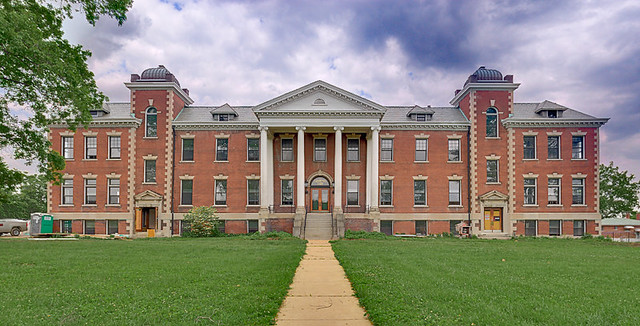
This is the former Loretto Academy, dating from 1909 and inspired by Osterley Park in London. As Catholics moved out of the neighborhood, the Sisters of Loretto merged this school with Nerinx Hall in Webster Groves in 1952. In recent years the building become increasingly run-down and was recently boarded-up. The former Academy is located on Lafayette Avenue facing Interstate 44, near Grand Boulevard. It is adjacent to the medical campus of Saint Louis University.
But now it is being redeveloped by the Central and Southern provinces of the Ordo Prædicatorum, the Order of Preachers — the Dominicans friars — and will be the residence for their seminarians. Since 1981, the Dominicans have been living in Jesuit Hall on the campus of SLU, but a great increase in vocations to the priesthood and religious life in recent years means that they need new quarters.
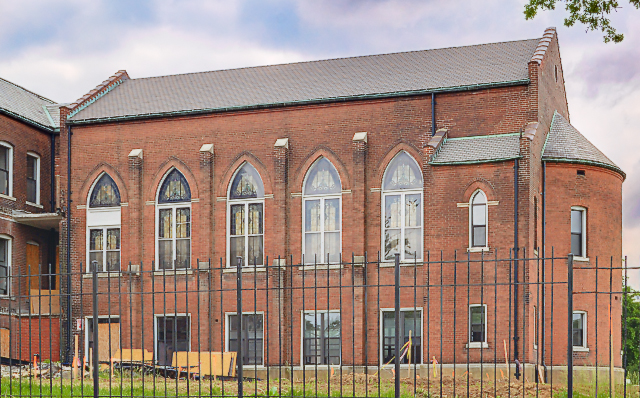
A view of the chapel.
The Saint Dominic Priory website has more information on the reconstruction, including architectural renderings and historical photos of the Academy.
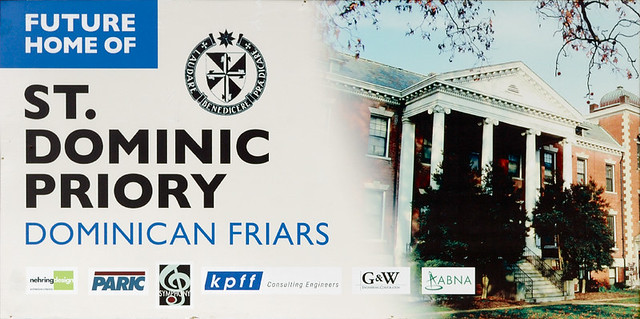
A sign in front of the building.

This is the former Loretto Academy, dating from 1909 and inspired by Osterley Park in London. As Catholics moved out of the neighborhood, the Sisters of Loretto merged this school with Nerinx Hall in Webster Groves in 1952. In recent years the building become increasingly run-down and was recently boarded-up. The former Academy is located on Lafayette Avenue facing Interstate 44, near Grand Boulevard. It is adjacent to the medical campus of Saint Louis University.
But now it is being redeveloped by the Central and Southern provinces of the Ordo Prædicatorum, the Order of Preachers — the Dominicans friars — and will be the residence for their seminarians. Since 1981, the Dominicans have been living in Jesuit Hall on the campus of SLU, but a great increase in vocations to the priesthood and religious life in recent years means that they need new quarters.

A view of the chapel.
The Saint Dominic Priory website has more information on the reconstruction, including architectural renderings and historical photos of the Academy.

A sign in front of the building.
Monday, May 23, 2011
Photos of Saint Gertrude Church, in Grantfork, Illinois
HERE ARE PHOTOS of Saint Gertrude Church, located in the village of Grantfork, in eastern Madison County, Illinois. The church is a part of the Diocese of Springfield in Illinois, and is approximately 37 highway miles northeast of downtown Saint Louis.

The cornerstone of the church reads:
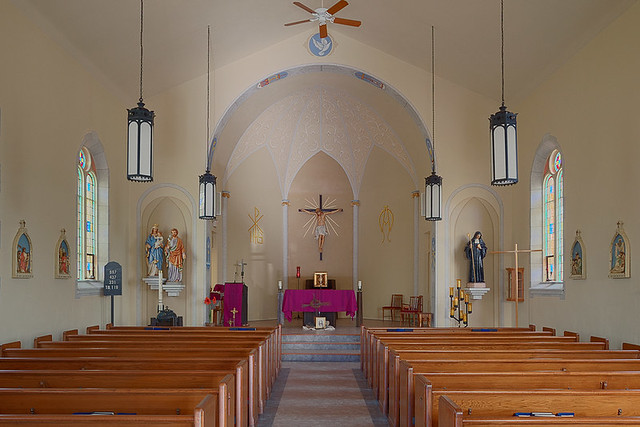
According to diocesan statistics, Saint Gertrude's Church has about 305 parishioners in 101 families.
The village of Grantfork was originally called Fitz James, then Saline, and then Grant Fork. According to a history of Madison County, dating from 1882:
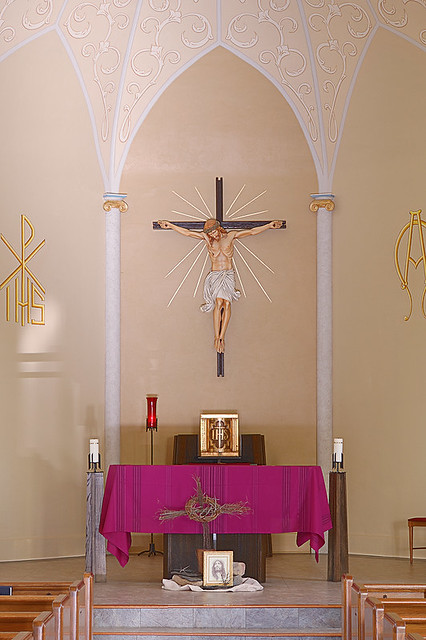
I took these photos on the Saturday in the fourth week of Lent, the eve of Passion Sunday. Depicted before the altar is the Crown of Thorns, one of the instruments of Our Lord's Passion.
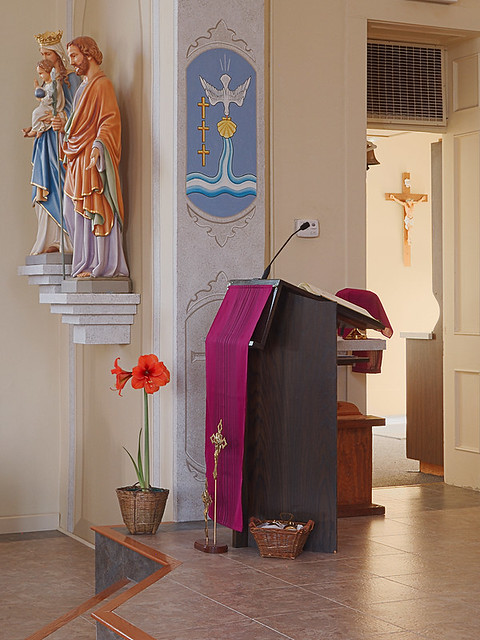
Symbols are depicted on the arch surrounding the sanctuary; shown here is a painting of the waters of baptism, with the traditional baptismal shell and the Holy Spirit descending in the form of a dove. On the left is the Holy Family.

Statue of Saint Gertrude the Great (6 January 1256 — 17 November 1301 or 1302). She was a Benedictine nun, a visionary and a mystic, known for her great devotion to the Sacred Heart of Jesus and to the Holy Souls in Purgatory. Her writings were approved by Dominican and Franciscan friars, and highly recommended by Saint Teresa of Avila, Saint Francis de Sales, and Dom Prosper Guéranger.
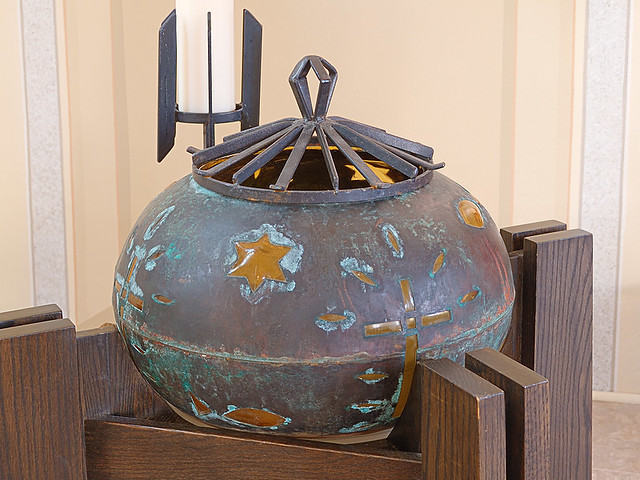
The baptismal font has an unusual design.
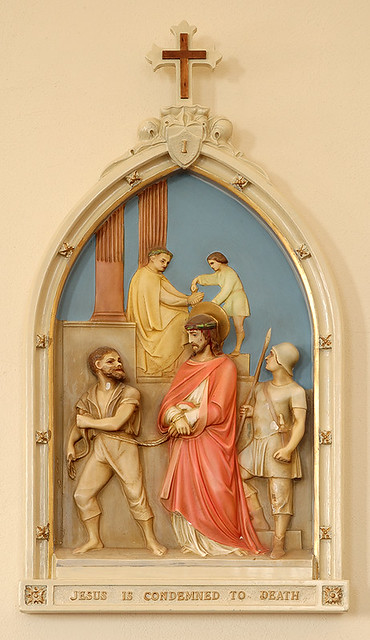
The First Station of the Cross — Jesus is condemned to death.
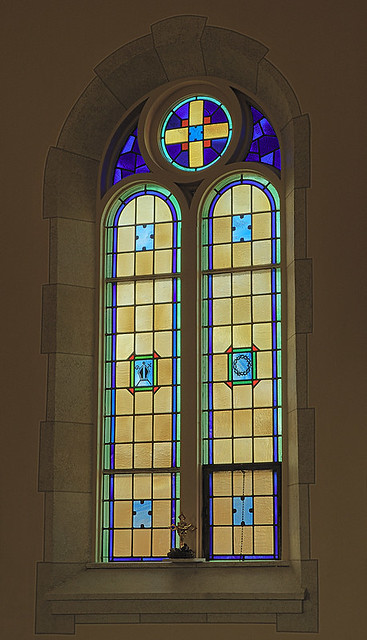
The stained glass windows in the church are simple but include symbolism. On the left is a miter with a crozier and processional cross in saltier — a heraldic symbol of a Catholic bishop; on the right is the Crown of Thorns.
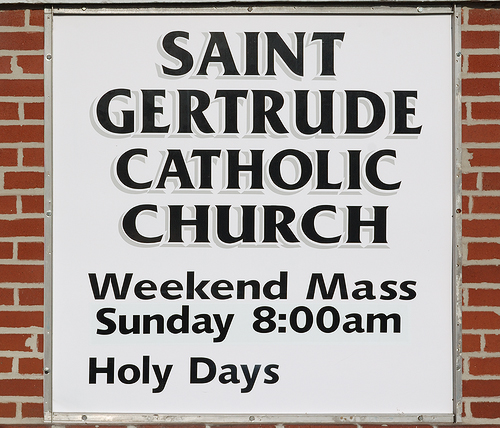
Address:
202 North Locust Street
Grantfork, Illinois

The cornerstone of the church reads:
SAINT GERTRUDE'S CHURCHThe parish dates from 1872.
REBUILT AD 1904

According to diocesan statistics, Saint Gertrude's Church has about 305 parishioners in 101 families.
The village of Grantfork was originally called Fitz James, then Saline, and then Grant Fork. According to a history of Madison County, dating from 1882:
This is a pleasant little village of about one hundred and fifty inhabitants, lying on the township line, partly in Leef and partly in Saline townships. It was first called Fitz James, and was laid out in 1840, by Henry K. Lathey, James Carpenter, George Fulls, Jonas R. Gale, Z. Lowe, and William F. De Wolf, on the southeast quarter of the south-west quarter section thirty-three. John Duncan opened a store in 1840. His house stood on the north side of the road that runs on the township line. He kept a public house, and put up a large sign inscribed in prominent letters "Fitz James Hotel by John Duncan." He continued here in a fair paying business, until his death, after which the buildings were burned. Some years after this, the town in the meantime making little progress R. D. Leggitt put up a second store. This also stood on the north side of the road. After about two years, he sold out to William Schum, who subsequently sold to John Bardill and brothers. Mr. Bardill afterward purchased his brother's interest in the store and conducted the business for many years. He was instrumental in getting a post-office established, called Saline. The department ordered the name changed, and the citizens christened it Grant Fork, which is the present name of the post-office. Martin Ruch, in the early history of the village, opened a store on the south side, where he is still engaged in business. In 1840 one Herrin opened a blacksmith shop in a little log cabin that stood just cast of the Douglas store building. He was not an expert at his trade, but could mend a chain or clevis, and was looked upon as quite an acquisition to the settlement. He afterward left, and for many years there was no blacksmith. John Link was the second smith. The Catholic church is a handsome brick edifice, built in 1872. There is a school conducted in connection with the church. The Lutheran church is a neat brick structure erected the same year. The public school is a brick building, one story high, with two rooms, in charge of James Lane at the present writing.Grantfork is located on what was once the great Illinois prairie. It sits on the right bank of Silver Creek, just before the creek forms the Highland Silver Lake reservoir. According to the 2010 census, the village has 337 residents.

I took these photos on the Saturday in the fourth week of Lent, the eve of Passion Sunday. Depicted before the altar is the Crown of Thorns, one of the instruments of Our Lord's Passion.

Symbols are depicted on the arch surrounding the sanctuary; shown here is a painting of the waters of baptism, with the traditional baptismal shell and the Holy Spirit descending in the form of a dove. On the left is the Holy Family.

Statue of Saint Gertrude the Great (6 January 1256 — 17 November 1301 or 1302). She was a Benedictine nun, a visionary and a mystic, known for her great devotion to the Sacred Heart of Jesus and to the Holy Souls in Purgatory. Her writings were approved by Dominican and Franciscan friars, and highly recommended by Saint Teresa of Avila, Saint Francis de Sales, and Dom Prosper Guéranger.

The baptismal font has an unusual design.

The First Station of the Cross — Jesus is condemned to death.

The stained glass windows in the church are simple but include symbolism. On the left is a miter with a crozier and processional cross in saltier — a heraldic symbol of a Catholic bishop; on the right is the Crown of Thorns.

Address:
202 North Locust Street
Grantfork, Illinois
Saturday, May 21, 2011
Rapture and the Gnostic Tendency
IF YOU ARE reading this, then you haven't been raptured! Poor Harold Camping and his followers, getting their hopes dashed. We really ought to take pity on these, some of whom gave up everything for an unrealized hope.
But this is nothing new.
Rather, instead imagine a group of Franciscan sisters, very much in the spirit of Vatican 2: they have shed their habits and have gone beyond Jesus and the oppressive institutional male church, embracing instead a more global consciousness. They do not preach the doctrine of Hell, but rather they are in tune with the ancient wisdom of native peoples, and — as Francis himself no doubt would have done in a more enlightened era — are moving towards a holistic Environmentalist ethic. The good sisters are known for holding rather exclusive retreats, attended by prominent academics, celebrities, and progressive politicians. Their core message is that the Earth is dying, and environmental catastrophes will soon occur because of industrialization and consumerism; very many people will undoubtably die due to global climate change, but this will trigger a new age of humanity with a better way of life for those who are left behind — an age without a church. Our sisters of Saint Francis are a vanguard group, the new way of doing church as envisioned by the Council, and are highly respected by the primary agents of change in our contemporary culture. The sisters defend their charism with the help of highly-regarded scriptural scholars, whose critical exegesis brings to light a historical Biblical worldview quite alien to the naïvely simplistic and literalistic reading preferred by reactionaries in the church (e.g., Pope Benedict and Cardinal Burke).
Even though my Franciscan sisters are imaginary, undoubtably the description is familiar; likewise my stereotypical Camping listener ought to sound plausible. However, I think it is fairly obvious that both groups seem to have a lot in common, including a doomsday scenario, a rejection of ecclesiology, the thought that we are entering a new age, the denial of Hell, salvation being limited to a self-selected elite, and twisting Sacred Scripture in novel ways to mean whatever they want it to mean, contrary to thousands of years of understanding. They both seem to express the same inclination in two different ways.
This inclination is perhaps broadly called gnostic, although I call it that with reservation. Gnosticism was the very first heresy in the Church, traditionally founded by Simon Magus, who wanted to purchase Saint Peter's power of miracles. It is from Simon Magus that we get the name of the sin of simony, the buying and selling of ecclesiastical offices. Many intellectuals have used the word gnostic to describe the worldview of people who are suffering under the modern malaise; however, Catholic apologist Jimmy Akin writes about the overuse of the word gnostic in an article here.
This gnostic tendency pops up frequently, and is especially popular today. While the news media may not be treating Camping's doomsday scenario seriously, the Mayan Calendar doomsday — December 21st, 2012 — is getting far more serious press, if only to refute it. Environmental doom, however, is reported as an established fact, and certainly is far more plausible to elite culture.
This is not new. The Joachimites, followers of the Sicilian mystic, Joachim of Flora (ca. 1135-1202), believed that a new age of the world would come in the year 1260: the world would be unified in eternal peace (and ruled by the Franciscans) without need for law or church.
The American Baptist preacher, William Miller, predicted that the world would come to an end sometime in the year following March 21st in 1843. (Why do doomsayers like to use the 21st day of the month?) He gained tens or hundreds of thousands of followers; but when the world did not end, this led to what was called the Great Disappointment.
But do not think that these failed prophesies led to skepticism or to a widespread rejection of religion, or that people discarded the notion that we can predict the end of the world. Miller's failure at predicting the end of the world rather led to even more radical sects, which moved even farther from orthodoxy and towards gnosticism. The failure of the Millerites led to the anti-Trinitarian Jehovah's Witnesses and Adventists, and even gave impetus to the Bahá'í in Persia. The failure of the otherwise fairly orthodox Franciscan Joachimites eventually led, in the 1300s, to numerous gnostic-like sects completely outside of the Church.
The new sects formed out of failed doomsday prophesies tend to be very potent, proselytizing far more intensely than any mainstream religion, and their ideas eventually can become engrained in our culture. How many times have you heard that the God of the Old Testament is angry and judgmental, while the God of the New Testament is nice and loving (despite the praises of the mercy and love of God in the O.T., and the promise of Christ being the Lion of Judah who will rule the nations with a rod of iron in the N.T.)? This came from the Joachimites. Some even claim that Naziism and Marxism are rooted in the same source. Millerite-style prophesies of the end-times are extremely common, as we see today.
The presence of elite, doomsday-preaching, scripture-interpreting gnostic-leaning sects is not the end of our story. It gets worse. We get new, more radical sects in the wake of failed prophesy; but some of these groups are not content to wait for the end of the world; rather, they mean to cause the end of the world.
The German-born political scientist Erich Hermann Wilhelm Vögelin (1901-1985) worked to discern the causes of the violent totalitarian political systems of the 20th century, including Naziism and Communism. He concluded that this violence was due to the gnostic tendency. Some people become alienated from society, and so come to believe that this alienation is due to the inherent evil and disorder of the material world. Like-minded alienated people come together into a sect, having determined that they alone have discovered the secret knowledge that can save humanity, and thereafter act as harbingers of doom.
These gnostics form an elite, and may see themselves as god-men, supermen or Übermensch, or an intellectual vanguard. As they alone have the knowledge of salvation, and due to their alienation from society, they undoubtably will have little regard for the vast bulk of humanity. It is natural to assume that these people would want to change the world for the better. But since these people are alienated from the world, and despise most the world's inhabitants, they would likely be open to changing the world by any means necessary, including widespread destruction.
According to Vögelin, the end-stage of the gnostic tendency is the willingness to “immanentize the eschaton”, that is, bring about in history the final, perfected stage of human society, to create universal peace, Heaven on Earth. We found this in the despotic regimes of the 20th century, and we see this with contemporary transhumanists or in those who promote the Technological Singularity. (By the way, tornadoes and hurricanes are the closest things to singularities that we find on Earth. When one of these near-singularities go by a place, indeed we find peace, for most everyone is dead.)
For the Joachimites, their eternal peace would come through an unprecedented world-wide crusade, where all the world's nations would forcibly come under their submission. For the greatly disappointed Millerites, the extremely violent American Civil War was the solution to their problem of injustice. (And some would say that the U.S. entry into the First World War was a continuation of the same ideology).
Environmentalists have been predicting worldwide biological catastrophes since the 1960s. These prophesies of doom have often gone unheeded — and unfulfilled. And so the sects have grown every more radical, from first suggesting that industry ought to voluntarily cut pollution emissions, until now, where they demand that the world population be cut by billions, and quickly. Radical indeed, and potentially bloody on an unprecedented scale. But they promise a return to Eden.
Extreme technophiles predict a new age of peace and prosperity that will occur after the revolution when the Machines take over. But haven't these people seen any science fiction film made in the past 45 years? Intelligent robots almost always turn into violent killing machines. Is that what they really want? Perhaps, if they have the gnostic tendency. See C.S. Lewis' book The Abolition of Man for a clear refutation of the idea of salvation through technology.
Violence, war, revolution, and strife are the fruits of the gnostic tendency. If matter is evil, then why should someone worry about death and destruction? If we experience times of peace, then undoubtably the gnostic tendency would prefer abortion and euthanasia. It's all pretty much the same. There will be peace when everyone is dead.
But we should recall that the eschaton has already been immanentized, in the Person of Christ. We have been living in the End Times for nearly 2,000 years. Christ Himself repeatedly told us that we would not know the day and the hour of the End, that it will come like a thief in the night.
From the Catechism of the Catholic Church, Canon 676:
But this is nothing new.
 |
| (Image source unknown) |
Imagine, if you will, Harold Camping's followers. These are poor, alienated, uneducated working class people, the bitter clingers holding on to their guns, booze, and bibles as the only constants in their life. These lonely, desperate people listen to Mr. Camping on their cheap AM radios late at night, and undoubtably believe that he is their only true friend. They hope that God will rapture them away from all this misery, and in this they are confident that they are one of the elect, the saved. Sadly, those of us who are left behind will be destroyed soon after, with certain knowledge that nothing will save us. These followers are of course profoundly ignorant, and oppose every societal initiative that will make their lives better. Mr. Camping himself shows a profound ignorance of the Bible, picking only those verses which support his theories. His historical timeline is also arbitrarily manufactured. Camping is definitely an oddity; he no longer belongs to any organized church (he claims the Age of the Church is now over) and holds to the unusual doctrine of annihilationism. He gets his conservative Protestant message out to his followers through his ownership of a large number of radio stations.
Rather, instead imagine a group of Franciscan sisters, very much in the spirit of Vatican 2: they have shed their habits and have gone beyond Jesus and the oppressive institutional male church, embracing instead a more global consciousness. They do not preach the doctrine of Hell, but rather they are in tune with the ancient wisdom of native peoples, and — as Francis himself no doubt would have done in a more enlightened era — are moving towards a holistic Environmentalist ethic. The good sisters are known for holding rather exclusive retreats, attended by prominent academics, celebrities, and progressive politicians. Their core message is that the Earth is dying, and environmental catastrophes will soon occur because of industrialization and consumerism; very many people will undoubtably die due to global climate change, but this will trigger a new age of humanity with a better way of life for those who are left behind — an age without a church. Our sisters of Saint Francis are a vanguard group, the new way of doing church as envisioned by the Council, and are highly respected by the primary agents of change in our contemporary culture. The sisters defend their charism with the help of highly-regarded scriptural scholars, whose critical exegesis brings to light a historical Biblical worldview quite alien to the naïvely simplistic and literalistic reading preferred by reactionaries in the church (e.g., Pope Benedict and Cardinal Burke).
 |
| Harold Camping being raptured. Drawing by Owen Swain; image source here. Used with permission. |
Even though my Franciscan sisters are imaginary, undoubtably the description is familiar; likewise my stereotypical Camping listener ought to sound plausible. However, I think it is fairly obvious that both groups seem to have a lot in common, including a doomsday scenario, a rejection of ecclesiology, the thought that we are entering a new age, the denial of Hell, salvation being limited to a self-selected elite, and twisting Sacred Scripture in novel ways to mean whatever they want it to mean, contrary to thousands of years of understanding. They both seem to express the same inclination in two different ways.
This inclination is perhaps broadly called gnostic, although I call it that with reservation. Gnosticism was the very first heresy in the Church, traditionally founded by Simon Magus, who wanted to purchase Saint Peter's power of miracles. It is from Simon Magus that we get the name of the sin of simony, the buying and selling of ecclesiastical offices. Many intellectuals have used the word gnostic to describe the worldview of people who are suffering under the modern malaise; however, Catholic apologist Jimmy Akin writes about the overuse of the word gnostic in an article here.
This gnostic tendency pops up frequently, and is especially popular today. While the news media may not be treating Camping's doomsday scenario seriously, the Mayan Calendar doomsday — December 21st, 2012 — is getting far more serious press, if only to refute it. Environmental doom, however, is reported as an established fact, and certainly is far more plausible to elite culture.
This is not new. The Joachimites, followers of the Sicilian mystic, Joachim of Flora (ca. 1135-1202), believed that a new age of the world would come in the year 1260: the world would be unified in eternal peace (and ruled by the Franciscans) without need for law or church.
The American Baptist preacher, William Miller, predicted that the world would come to an end sometime in the year following March 21st in 1843. (Why do doomsayers like to use the 21st day of the month?) He gained tens or hundreds of thousands of followers; but when the world did not end, this led to what was called the Great Disappointment.
But do not think that these failed prophesies led to skepticism or to a widespread rejection of religion, or that people discarded the notion that we can predict the end of the world. Miller's failure at predicting the end of the world rather led to even more radical sects, which moved even farther from orthodoxy and towards gnosticism. The failure of the Millerites led to the anti-Trinitarian Jehovah's Witnesses and Adventists, and even gave impetus to the Bahá'í in Persia. The failure of the otherwise fairly orthodox Franciscan Joachimites eventually led, in the 1300s, to numerous gnostic-like sects completely outside of the Church.
The new sects formed out of failed doomsday prophesies tend to be very potent, proselytizing far more intensely than any mainstream religion, and their ideas eventually can become engrained in our culture. How many times have you heard that the God of the Old Testament is angry and judgmental, while the God of the New Testament is nice and loving (despite the praises of the mercy and love of God in the O.T., and the promise of Christ being the Lion of Judah who will rule the nations with a rod of iron in the N.T.)? This came from the Joachimites. Some even claim that Naziism and Marxism are rooted in the same source. Millerite-style prophesies of the end-times are extremely common, as we see today.
The presence of elite, doomsday-preaching, scripture-interpreting gnostic-leaning sects is not the end of our story. It gets worse. We get new, more radical sects in the wake of failed prophesy; but some of these groups are not content to wait for the end of the world; rather, they mean to cause the end of the world.
The German-born political scientist Erich Hermann Wilhelm Vögelin (1901-1985) worked to discern the causes of the violent totalitarian political systems of the 20th century, including Naziism and Communism. He concluded that this violence was due to the gnostic tendency. Some people become alienated from society, and so come to believe that this alienation is due to the inherent evil and disorder of the material world. Like-minded alienated people come together into a sect, having determined that they alone have discovered the secret knowledge that can save humanity, and thereafter act as harbingers of doom.
These gnostics form an elite, and may see themselves as god-men, supermen or Übermensch, or an intellectual vanguard. As they alone have the knowledge of salvation, and due to their alienation from society, they undoubtably will have little regard for the vast bulk of humanity. It is natural to assume that these people would want to change the world for the better. But since these people are alienated from the world, and despise most the world's inhabitants, they would likely be open to changing the world by any means necessary, including widespread destruction.
According to Vögelin, the end-stage of the gnostic tendency is the willingness to “immanentize the eschaton”, that is, bring about in history the final, perfected stage of human society, to create universal peace, Heaven on Earth. We found this in the despotic regimes of the 20th century, and we see this with contemporary transhumanists or in those who promote the Technological Singularity. (By the way, tornadoes and hurricanes are the closest things to singularities that we find on Earth. When one of these near-singularities go by a place, indeed we find peace, for most everyone is dead.)
For the Joachimites, their eternal peace would come through an unprecedented world-wide crusade, where all the world's nations would forcibly come under their submission. For the greatly disappointed Millerites, the extremely violent American Civil War was the solution to their problem of injustice. (And some would say that the U.S. entry into the First World War was a continuation of the same ideology).
Environmentalists have been predicting worldwide biological catastrophes since the 1960s. These prophesies of doom have often gone unheeded — and unfulfilled. And so the sects have grown every more radical, from first suggesting that industry ought to voluntarily cut pollution emissions, until now, where they demand that the world population be cut by billions, and quickly. Radical indeed, and potentially bloody on an unprecedented scale. But they promise a return to Eden.
Extreme technophiles predict a new age of peace and prosperity that will occur after the revolution when the Machines take over. But haven't these people seen any science fiction film made in the past 45 years? Intelligent robots almost always turn into violent killing machines. Is that what they really want? Perhaps, if they have the gnostic tendency. See C.S. Lewis' book The Abolition of Man for a clear refutation of the idea of salvation through technology.
Violence, war, revolution, and strife are the fruits of the gnostic tendency. If matter is evil, then why should someone worry about death and destruction? If we experience times of peace, then undoubtably the gnostic tendency would prefer abortion and euthanasia. It's all pretty much the same. There will be peace when everyone is dead.
But we should recall that the eschaton has already been immanentized, in the Person of Christ. We have been living in the End Times for nearly 2,000 years. Christ Himself repeatedly told us that we would not know the day and the hour of the End, that it will come like a thief in the night.
From the Catechism of the Catholic Church, Canon 676:
The Antichrist's deception already begins to take shape in the world every time the claim is made to realize within history that messianic hope which can only be realized beyond history through the eschatological judgement. The Church has rejected even modified forms of this falsification of the kingdom to come under the name of millenarianism, especially the "intrinsically perverse" political form of a secular messianism.We must always be prepared. Let us not forget that each one of us is facing our own personal End of the World and Judgement Day, which can come any time, and without any warning. That the ultimate End comes on Saturday means little if you die on Wednesday.
Friday, May 20, 2011
"Wake up frosh, it's Ditch Day!"
ACCORDING TO AN email from my alma mater Caltech:
Seniors, during finals week, would play this song at extremely high volume at dawn. Not a pleasant way to be woken: and to this day, my stomach still ties itself into knots whenever I hear it. But on one of those days, seniors would run through the halls of the Houses screaming "Wake up frosh, it's Ditch Day!" before abandoning the campus. That was the most exciting day of the Caltech year, for all studies and final exams were forgotten. (Frosh is the Caltech nickname for first year students, or freshman.)
Caltech is governed by the Honor Code, a system whereby “No member of the Caltech community shall take unfair advantage of any other member of the Caltech community,” enforced by the greatly feared Board of Control. This Code means that all exams are take-home, and it also means that participants in Ditch Day must honorably follow the Code also.
The underclassmen would attempt to break into the seniors' rooms, but were on their honor to do so according to the directions left by the seniors on their doors — which are called ‘stacks’. The seniors were also honorably expected to provide puzzles or tasks that were entertaining, clever, not too deadly, and not impossible or unreasonably obscure. If the underclassmen determined that a particular senior acted dishonorably in stacking his room, they would counterstack it. Seniors would leave valuable bribes in their rooms to prevent counterstacks.
On my Ditch Day, I provided a series of photos taken around campus. These were in obscure areas — not too difficult, not too easy — which the underclassmen had to discover. At each location I left a sticker which had a code written on it. After the underclassmen found all the codes, they continued on with additional puzzles based on the codes. Alas, while they found the first part of my stack enjoyable, they thought that the second part of the puzzle was unsolvable. I returned to my room that evening, finding it stacked floor-to-ceiling with Gothic Revival furniture.

From my days at Caltech. I'm third from the left.

More information on Ditch Day can be found here.
It's that time of year again, that one day when the Caltech campus becomes a barely-controlled, seemingly chaotic playground for groups of underclassmen working on stacks the absent seniors have left behind...I despise Wagner, and most especially The Ride of the Valkyries, from Der Ring des Nibelungen:
It's one of Caltech's oldest traditions-a cross between Animal House and a science fair. One day each spring, kept secret until the last minute, seniors ditch their classes and vanish from campus, leaving behind complex, imaginative scavenger hunts, mazes, puzzles, and other challenges that are carefully planned out to occupy the underclassmen-preventing them from wreaking havoc in the seniors' rooms.
Seniors, during finals week, would play this song at extremely high volume at dawn. Not a pleasant way to be woken: and to this day, my stomach still ties itself into knots whenever I hear it. But on one of those days, seniors would run through the halls of the Houses screaming "Wake up frosh, it's Ditch Day!" before abandoning the campus. That was the most exciting day of the Caltech year, for all studies and final exams were forgotten. (Frosh is the Caltech nickname for first year students, or freshman.)
Caltech is governed by the Honor Code, a system whereby “No member of the Caltech community shall take unfair advantage of any other member of the Caltech community,” enforced by the greatly feared Board of Control. This Code means that all exams are take-home, and it also means that participants in Ditch Day must honorably follow the Code also.
The underclassmen would attempt to break into the seniors' rooms, but were on their honor to do so according to the directions left by the seniors on their doors — which are called ‘stacks’. The seniors were also honorably expected to provide puzzles or tasks that were entertaining, clever, not too deadly, and not impossible or unreasonably obscure. If the underclassmen determined that a particular senior acted dishonorably in stacking his room, they would counterstack it. Seniors would leave valuable bribes in their rooms to prevent counterstacks.
On my Ditch Day, I provided a series of photos taken around campus. These were in obscure areas — not too difficult, not too easy — which the underclassmen had to discover. At each location I left a sticker which had a code written on it. After the underclassmen found all the codes, they continued on with additional puzzles based on the codes. Alas, while they found the first part of my stack enjoyable, they thought that the second part of the puzzle was unsolvable. I returned to my room that evening, finding it stacked floor-to-ceiling with Gothic Revival furniture.

From my days at Caltech. I'm third from the left.

More information on Ditch Day can be found here.
Wednesday, May 18, 2011
"Light Show at Amiens"
“NEGLECTFUL CENTURIES have seen the great churches of the High Middle Ages lose one of their most striking characteristics: color. Traces of pigment reveal that many were once brightly polychromed, both on the interior and on the exterior.”— from the article LIGHT SHOW at AMIENS, at The Lion and the Cardinal.
However, I don't think we ought to believe that the churches were painted so garishly as depicted in the article's photographs. But the church was illuminated by lasers, which tend to produce pure colors, and so subtlety likely cannot be depicted. With such fine stone craftsmanship used in these great churches, undoubtably equally fine painting was also used.
Only recently have scholars determined that the buildings and statuary of classical antiquity were also painted — demolishing centuries of Enlightenment art theory. However, these scholars very much think that the colors were garish and ugly. That can't be true: see my article here.
The famous Gothic revival of the 19th century was based on the mistaken notion that the medieval churches were plain stone; perhaps this false supposition led to the eventual rejection of the Gothic in the 20th century. A new revival of this style will likely be impossible if garish and ugly colors are thought to be "authentic".
Tuesday, May 17, 2011
Eucharistic Congress, June 24-26 2011

The 2011 Eucharistic Congress will be held in Saint Louis on June 24-26. Guests will include His Eminence Raymond Leo Cardinal Burke, the Most Reverend George J. Lucas, the Reverend Robert Reed, and Audrey Assad and the Ike Ndolo Band.
More information: facebook.com/StlEuchCongress and archstl.org/eucharist.
Sunday, May 15, 2011
Newsletter from the Oratory
 SAINT FRANCIS DE SALES ORATORY EMAIL NEWSLETTER 2653 Ohio Avenue Saint Louis, Missouri 63118 www.institute-christ-king.org www.TraditionForTomorrow.com 314-771-3100 | ||
|
Friday, May 13, 2011
Instruction Universae Ecclesiae
THE PONTIFICAL COMMISSION Ecclesia Dei has today released the instruction Universae Ecclesiae, which regulates the use of the old Latin liturgy as found before the Second Vatican Council.
Others can describe this instruction better than me.
Others can describe this instruction better than me.
Blogging Interruption
THE BLOGGER.COM system I use for this website had technical problems for a few days, and all blog postings created since Wednesday were deleted. However, I can't use this as an excuse, since I haven't been posting out of sheer sloth.
But here is a picture of the Missouri River, taken at night a week or so ago:
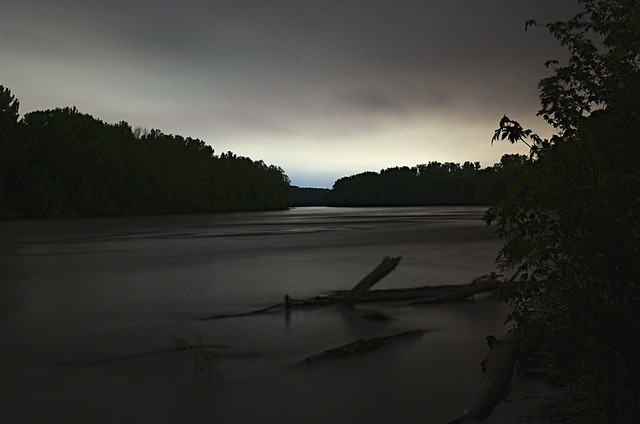
This is the Centaur Chute with Howell Island on the left. If you click the photo twice you can see it displayed on a black background.
But here is a picture of the Missouri River, taken at night a week or so ago:

This is the Centaur Chute with Howell Island on the left. If you click the photo twice you can see it displayed on a black background.
Saturday, May 07, 2011
"Don't encourage Arab revolutions"
“OUR ARAB countries are not ready for revolutions”, says Melkite Catholic Patriarch Gregorios III. Violence and crime will get worse if these revolutions are allowed to continue, he says. “Christians especially are very fragile in the face of crises and bloody revolutions.”
Read the full article here, from the Catholic News Agency.
Read the full article here, from the Catholic News Agency.
Thursday, May 05, 2011
Annual Fatima Novena
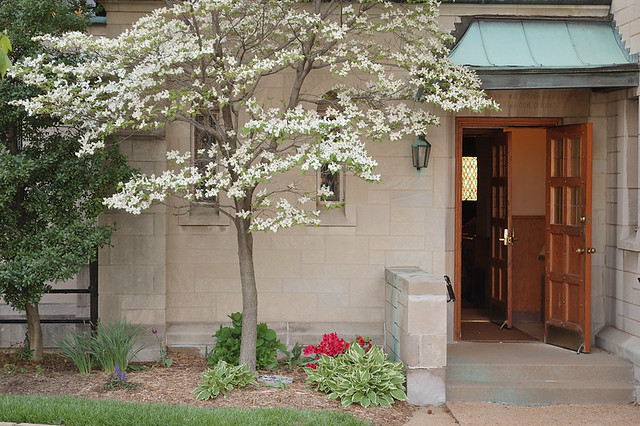
Side entrance to Saint Mary Magdalen Church, in Brentwood, Missouri.
Annual Fatima Novena
May 5—May 13, 2011
Saint Mary Magdalen Church
2618 Brentwood Boulevard at Manchester Road
7 p.m Rosary — 7:30 p.m. Holy Mass
May 5—May 13, 2011
Saint Mary Magdalen Church
2618 Brentwood Boulevard at Manchester Road
7 p.m Rosary — 7:30 p.m. Holy Mass
Featured speakers:
May 5—Rev. Noah Waldman
May 6—Msgr. Mark Rivituso
May 7—Bishop Robert Hermann
May 8—Rev. David Wichlan
May 9—Rev. Albert Mattler
May 10—Rev. Joseph Jiang
May 11—Rev. Anthony Yates
May 12—Rev. Jack Siefert
May 13—Rev. Brian Harrison, O.S.
Wednesday, May 04, 2011
A Long-Standing Problem
THIS SEEMS vaguely relevant:
Starting in about the 1940s, Christianity in the middle-east has been in a particularly sharp decline. Modern nation-building, promoted by the secular West, has caused untold hardship for the Christians in those places. Wars and revolutions now taking place are making things far worse for them. Our secularist leaders seem to have no pity for Christians, who are seen more as problem rather than souls in need of mercy and protection.
Giles and Electe, who anxiously aspired to martyrdom, and who were only lay-brothers, had appeared to St. Francis to be more fit to be sent to the Saracens than even those of the clergy, and they hastened to go into Africa with several others. What chiefly animated the zeal of brother Giles, as the author of his life remarks, was his having heard that the Saracens treated with great cruelty those Christians who spoke ill of the law of Mahomet. When he reached Tunis with a party of missionaries, he generously preached the faith in public, and this continued for some time. A person who was looked up to among the Saracens for his great wisdom, having come forth from his retreat, told the people that they ought to put to the sword all those infidels who spoke against the law of their prophet. Giles and his companions were delighted at the prospect of an early martyrdom; but the Christians with whom they had their domicile, fearing lest they might be included in the massacre, took away these preachers and compelled them to go on board a vessel in the harbor, and did not permit them again to land. As they did not cease addressing the Mahometans who crowded to the sea-shore, with a view to induce them to embrace the faith of Jesus Christ,—their desire to sacrifice their lives for His glory being so ardent,—the Christian residents hastened to have them removed to Europe. Thus seeing that even their fellow-believers were opposed to their views, they returned to Italy.— from The Life and Legends of Saint Francis of Assisi, by Father Candide Chalippe
Starting in about the 1940s, Christianity in the middle-east has been in a particularly sharp decline. Modern nation-building, promoted by the secular West, has caused untold hardship for the Christians in those places. Wars and revolutions now taking place are making things far worse for them. Our secularist leaders seem to have no pity for Christians, who are seen more as problem rather than souls in need of mercy and protection.
























